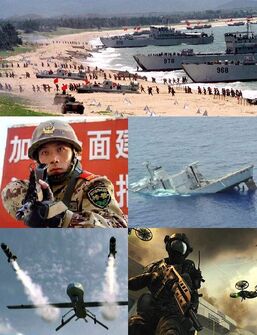| Taiwan War | |||||||
|---|---|---|---|---|---|---|---|
| Part of Second Chinese Civil War | |||||||
 Clockwise from top: The Chinese invasion force lands at Taiwan; the sinking of the U.S. arms freighter; a Taiwanese soldier and U.S. drones during the Battle of Changhua; a U.S. drone fires on Chinese forces; a Chinese soldier guards a checkpoint in Kaohsiung | |||||||
| |||||||
| Belligerents | |||||||
| Commanders | |||||||
|
|||||||
| Strength | |||||||
| 700,000 | 1,000,000 | ||||||
| Casualties and losses | |||||||
| 300,000 | 500,000 | ||||||
The Taiwan War was a war fought between the People's Republic of China and the Republic of China, following the PRC's invasion of Taiwan, the place of government of the ROC. The ROC was backed by the U.S. through weapons deals, until 2027, when the U.S. began hitting PRC targets with drone strikes and shipping the ROC quadcopter drones. Japan and the Philippines also sent weapons to Taiwan, while multiple other countries voiced support for the ROC.
Background[]
By the late 2020s, China was running out of allies. North Korea had fallen following a coup in 2022, while Pakistan was annexed by after a war in 2027. The Eurasian Union, in the meantime, while still remaining in BRICS and maintaining trade with the PRC, had begun to distance themselves from China, partly due to China's staunch communism and the E.A.U's capitalism.
The U.S., China's largest trading partner who also held a multi-trillion dollar debt to the nation, had become much more economically independent and had payed off a large portion of their debt to the PRC by 2025. China's once immense world influence, was slipping.
Xi Jinping's administration had seen a sharp spike in jingoism in China. Peng Lau, a self-described ultra-nationalist, continued Jiping's polices to the letter. Lau declared that Hong Kong and Macau would never see independence and threatened the western world, bombastically warning them to stay out of Asian affairs, or suffer consequences.
In 2026, Lau announced that Taiwan would be invaded in order to "unify China" and that the nation had become rogue. That same year, the U.S., Japan and the Philippines began sending weaponry and other aid to the ROC.
